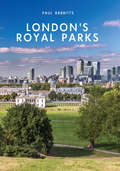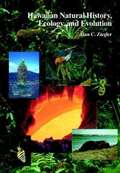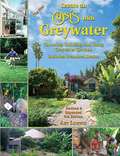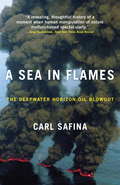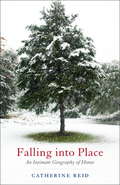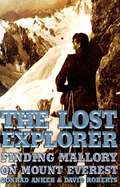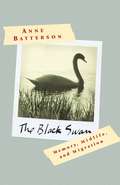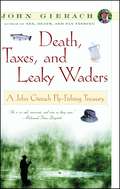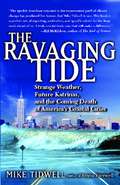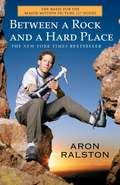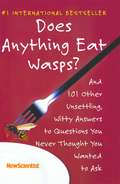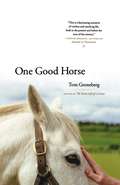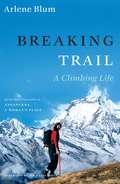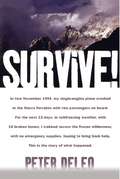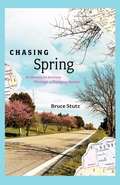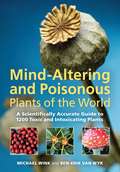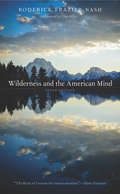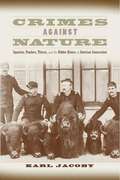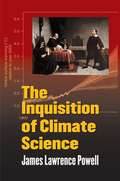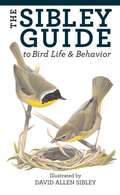- Table View
- List View
Terrestrial Biosphere-Atmosphere Fluxes
by Russell Monson Dennis BaldocchiFluxes of trace gases, water and energy - the 'breathing of the biosphere' - are controlled by a large number of interacting physical, chemical, biological and ecological processes. In this interdisciplinary book, the authors provide the tools to understand and quantitatively analyse fluxes of energy, organic compounds such as terpenes, and trace gases including carbon dioxide, water vapour and methane. It first introduces the fundamental principles affecting the supply and demand for trace gas exchange at the leaf and soil scales: thermodynamics, diffusion, turbulence and physiology. It then builds on these principles to model the exchange of water, carbon dioxide, terpenes and stable isotopes at the ecosystem scale. Detailed mathematical derivations of commonly used relations in biosphere-atmosphere interactions are provided for reference in appendices. An accessible introduction for graduate students and a key resource for researchers in related fields, such as atmospheric science, hydrology, meteorology, climate science, biogeochemistry and ecosystem ecology.
London's Royal Parks
by Paul RabbittsThis book tells the history of London's royal parks and how they have evolved from private hunting grounds and gardens into public spaces and venues for great events. In some cases, the parks were royally owned as long ago as the Norman conquest, and several of them were acquired by Henry VIII during the Reformation. At this time they were kept private and there was no public access, but during the eighteenth century most of the parks were opened to the public. Landscaping work was undertaken to keep up with trends, and the parks became fashionable places to be seen out and about - witness Rotten Row in Hyde Park. The parks, Hyde Park in particular, has been used to host major events such as the Great Exhibition and various jubilee and entertainment events. It tells the story of each of the nine royal parks from their acquisition by the monarchy through to the present day, outlining their use and management and the major historical moments associated with them.
Hawaiian Natural History, Ecology, and Evolution
by Alan C. ZieglerNot since Willam A. Bryans 1915 landmark compendium, Hawaiian Natural History, has there been a single-volume work that offers such extensive coverage of this complex but fascinating subject. Hawaiian Natural History, Ecology, and Evolution updates both the earlier publication and subsequent works by compiling and synthesizing in a uniform and accessible fashion the widely scattered information now available. An extensive annotated bibliography and a list of audio-visual materials will help readers locate additional sources of information.
Climate Change and the Course of Global History
by John L. BrookeClimate Change and the Course of Global History presents the first global study by a historian to fully integrate the earth-system approach of the new climate science with the material history of humanity. Part I argues that geological, environmental, and climatic history explain the pattern and pace of biological and human evolution. Part II explores the environmental circumstances of the rise of agriculture and the state in the Early and Mid-Holocene, and presents an analysis of human health from the Paleolithic through the rise of the state, including the Neolithic Demographic Transition. Part III introduces the problem of economic growth and examines the human condition in the Late Holocene from the Bronze Age through the Black Death, assessing the relationships among human technologies, climatic change, and epidemic disease. Part IV explores the move to modernity, stressing the emerging role of human economic and energy systems as earth-system agents in the Anthropocene. Supported by climatic, demographic, and economic data with forty-nine figures and tables custom-made for this book, A Rough Journey provides a pathbreaking model for historians of the environment, the world, and science, among many others.
North To Adventure
by K. M. PeytonNick knows he wants to work on the crew of a ship, so when his uncle puts together a crew for the Nimbus to go north looking for the Puffin, which was lost years earlier, Nick becomes the most junior member of its crew. In the rough arctic seas and landscape, Nick and his eskimo friend Utak save the day and find out the truth about the Puffin.
The New Create an Oasis With Greywater:Choosing, Building, and Using Greywater Systems (5th Edition)
by Art LudwigThis book describes how to choose, build, and use 20 types of residential greywater reuse systems in just about any context: urban, rural, or village.
A Sea in Flames: The Deepwater Horizon Oil Blowout
by Carl SafinaCarl Safina has been hailed as one of the top 100 conservations of the 20th century (Audubon Magazine) andA Sea in Flamesis his blistering account of the months-long manmade disaster that tormented a region and mesmerized the nation. Traveling across the Gulf to make sense of an ever-changing story and its often-nonsensical twists, Safina expertly deconstructs the series of calamitous misjudgments that caused theDeepwater Horizonblowout, zeroes in on BP’s misstatements, evasions, and denials, reassesses his own reaction to the government’s crisis handling, and reviews the consequences of the leak-and what he considers the real problems, which the press largely overlooked. Safina takes us deep inside the faulty thinking that caused the lethal explosion. We join him on aerial surveys across an oil-coated sea. We confront pelicans and other wildlife whose blue universe fades to black. Safina skewers the excuses and the silly jargon-like “junk shot” and “top kill”-that made the tragedy feel like a comedy of horrors-and highlighted Big Oil’s appalling lack of preparedness for an event that was inevitable. Based on extensive research and interviews with fishermen, coastal residents, biologists, and government officials,A Sea In Flameshas some surprising answers on whether it was “Obama’s Katrina,” whether the Coast Guard was as inept in its response as BP was misleading, and whether this worst unintended release of oil in history was really America’s worst ecological disaster. Impassioned, moving, and even sharply funny,A Sea in Flamesis ultimately an indictment of America’s main addiction. Safina writes: “In the end, this is a chronicle of a summer of pain-and hope. Hope that the full potential of this catastrophe would not materialize, hope that the harm done would heal faster than feared, and hope that even if we didn’t suffer the absolutely worst-we’d still learn the big lesson here. We may have gotten two out of three. That’s not good enough. Because: there’ll be a next time. ” From the Hardcover edition.
Falling into Place
by Catherine ReidQuietly powerful essays, weaving keenly observed insights into the mysteries of nature with those of family and community "It's not easy," Catherine Reid writes, "to love a person and a place in equal measure." Love she does, however, as described in these intimate, lyric essays about the land and people around her. With the inside perspective of a native daughter combined with her outsider status as a lesbian, Reid explores such paradoxes as those that arise from harnessing wild rivers or legalizing same-sex marriage. Her fascination with natural phenomena--whether bird hibernation, the arrival of fishers in suburbia, or the explosion of amphibious life in the wet weeks of spring--is captured in writing that pays as much attention to the sounds of a sentence as to the rhythms of the landscapes she wanders. Ultimately, however, Reid finds herself having to choose between her lover and her home place. Solace comes from companions as varied as a praying mantis, an otter, and her hundred-year-old grandmother, while resilience shows up in the stories of streams recovering from toxic spills and in communities weathering floods and town meetings. In essays both sensuous and provocative, Reid faces the beauty and challenges of our changing world head-on.
The Lost Explorer
by David Roberts Conrad AnkerThis is the adventure story of the year -- how Conrad Anker found the body of George Mallory on Mount Everest, casting an entirely new light on the mystery of the explorer who may have conquered Everest seventy-five years ago. On June 8, 1924, George Leigh Mallory and Andrew "Sandy" Irvine were last seen climbing toward the summit of Mount Everest. Clouds soon closed around them, and they vanished into history. Ever since, mountaineers have wondered whether they reached the summit twenty-nine years before Edmund Hillary and Tenzing Norgay. On May 1, 1999, Conrad Anker, one of the world's strongest mountaineers, discovered Mallory's body lying facedown, frozen into the scree and naturally mummified at 27,000 feet on Everest's north face. The condition of the body, as well as the artifacts found with Mallory, including goggles, an altimeter, and a carefully wrapped bundle of personal letters, are important clues in determining his fate. Seventeen days later, Anker free-climbed the Second Step, a 90-foot sheer cliff that is the single hardest obstacle on the north ridge. The first expedition known to have conquered the Second Step, a Chinese team in 1975, had tied a ladder to the cliff, leaving unanswered the question of whether Mallory could have climbed it in 1924. Anker's climb was the first test since Mallory's of the cliff's true difficulty. In treacherous conditions, Anker led teammate Dave Hahn from the Second Step to the summit. Reflecting on the climb, Anker explains why he thinks Mallory and Irvine failed to make the summit, but at the same time, he expresses his awe at Mallory's achievement with the primitive equipment of the time. Stunningly handsome and charismatic, Mallory charmed everyone who met him during his lifetime and continues to fascinate mountaineers today. He was an able writer, a favorite of the Bloomsbury circle, and a climber of legendary gracefulness. The Lost Exploreris the remarkable story of this extraordinarily talented man and of the equally talented modern climber who spearheaded a discovery that may ultimately help solve the mystery of Mallory's disappearance.
The Black Swan
by Anne BattersonSet against a spontaneous cross-country road trip following the migrating birds, this passionate, lyrical memoir is one woman's reflections on midlife, her important personal relationships, her kaleidoscopic past, and her uncertain future. To fifty-six-year-old Anne Batterson, a woman whose life has been filled with adventure -- as a commercial pilot, an international skydiving champion, a trekking guide in Nepal -- her husband's decision to retire felt like a death sentence. Yearning for some way to reconcile herself to the future that was rapidly unfolding before her, she packed up her VW camper and hit the road with maps, bird guides, and little else except the desire to follow the fall migration and the bone-deep hunch that birds had something important to teach her. In this beautifully written narrative of that extraordinary trip, Batterson writes movingly not only about her experiences with the birds but also about the people she loves, has lost, and connects with along the way. Events from the present trigger vivid stories from the past. In the chapter "The Journey Within the Journey," a long, lonely night in a deserted campground in Virginia conjures up the ghosts of a desperate solo road trip she made when she was twenty-one. A towering cumulus cloud in Illinois brings back a breathtaking free fall into a similar cloud in "My Time as a Bird. " An encounter with a great blue heron summons a compelling account of her mother's last afternoon in the world. "Bears in the Woods" describes a run-in with twoDeliverance-type men in West Virginia, which brings back the murder of a dear friend in the woods of Connecticut. By the end of the journey, the ghosts of the past, like the author herself, have become part of a more fluid, more spiritual reality -- wild and spare and elegant and timeless -- one that is always out there, "quickening on the far side of reality. "A unique mix of memoir and nature writing,The Black Swanis a charming story of a woman's odyssey.
Death, Taxes, and Leaky Waders
by John GierachDeath, Taxes, and Leaky Waders collects forty of John Gierach's finest essays on fishing from six of his books. Like all his writing, these essays are seasoned by a keen sense of observation and a deep knowledge and love of fishing lore, leavened by a wonderfully wry sense of humor. This is the first anthology of Gierach's work, a collection that is sure to delight both die-hard fans and new readers alike.
The Ravaging Tide: Strange Weather, Future Katrinas, and the Coming Death of America's Coastal Cities
by Mike TidwellIf, like many Americans, you believe the ongoing tragedy of Hurricane Katrina was a once-in-a-lifetime fluke, you need to read this book. In the coming years and decades, the safety of your region, your town, your home may depend on the warnings you'll encounter on these pages. That's because the exact same conditions that created the Katrina catastrophe and destroyed New Orleans are being replicated right now along virtually every inch of U. S. coastline. In The Ravaging Tide, Mike Tidwell, a renowned advocate for the environment and an award-winning journalist, issues a call to arms and confronts us with some unsettling facts. Consider: In the next seventy-five years, much of the Florida peninsula could lie under ocean water. So could much of Lower Manhattan, including all of the hallowed ground zero area. Major hurricanes like Katrina, scientists say, are becoming much more frequent and more powerful. Glacier National Park in Montana will have to change its name, as it is rapidly losing all of its thirty-five remaining glaciers. The snows atop Mt. Kilimanjaro in Africa, so memorably evoked in the Hemingway story, have already disappeared. The fault, Tidwell argues, lies mostly with the U. S. government and the energy choices it has encouraged Americans to make over the decades. Those policies are now actively bringing rising seas and gigantic hurricanes -- the lethal forces that killed the Big Easy -- crashing into every coastal city in the country and indeed the world. The Bush administration's own reports and studies (some of which it has tried to suppress) explicitly predict more intense storms and up to three feet of sea-level rise by 2100 due to planetary warming. The danger is clear: Whether the land sinks three feet per century (as in New Orleans over the past 100 years) or sea levels rise three feet per century (as in the rest of the world over the next 100 years), the resulting calamity is the same. Although Mike Tidwell sounds the clarion in The Ravaging Tide, this is ultimately an optimistic book, one that offers a clear path to a healthier and safer world for us and our descendants. He writes of trend-setting U. S. states like New York and California that are actively cutting greenhouse gases. And he heeds his own words: In one delightful personal chapter, he takes us on a tour of his suburban Washington, D.C., home and demonstrates how he and many of his neighbors have weaned themselves from the fossil-fuel lifestyle. Even when the government is slow to change, there are steps we as families can take to, yes, change the world.
Between a Rock and a Hard Place
by Aron RalstonOne of the most extraordinary survival stories ever told -- Aron Ralston's searing account of his six days trapped in one of the most remote spots in America, and how one inspired act of bravery brought him home. It started out as a simple hike in the Utah canyonlands on a warm Saturday afternoon. For Aron Ralston, a twenty-seven-year-old mountaineer and outdoorsman, a walk into the remote Blue John Canyon was a chance to get a break from a winter of solo climbing Colorado's highest and toughest peaks. He'd earned this weekend vacation, and though he met two charming women along the way, by early afternoon he finally found himself in his element: alone, with just the beauty of the natural world all around him. It was 2:41 P.M. Eight miles from his truck, in a deep and narrow slot canyon, Aron was climbing down off a wedged boulder when the rock suddenly, and terrifyingly, came loose. Before he could get out of the way, the falling stone pinned his right hand and wrist against the canyon wall. And so began six days of hell for Aron Ralston. With scant water and little food, no jacket for the painfully cold nights, and the terrible knowledge that he'd told no one where he was headed, he found himself facing a lingering death -- trapped by an 800-pound boulder 100 feet down in the bottom of a canyon. As he eliminated his escape options one by one through the days, Aron faced the full horror of his predicament: By the time any possible search and rescue effort would begin, he'd most probably have died of dehydration, if a flash flood didn't drown him before that. What does one do in the face of almost certain death? Using the video camera from his pack, Aron began recording his grateful good-byes to his family and friends all over the country, thinking back over a life filled with adventure, and documenting a last will and testament with the hope that someone would find it. (For their part, his family and friends had instigated a major search for Aron, the amazing details of which are also documented here for the first time.) The knowledge of their love kept Aron Ralston alive, until a divine inspiration on Thursday morning solved the riddle of the boulder. Aron then committed the most extreme act imaginable to save himself. Between a Rock and a Hard Place -- a brilliantly written, funny, honest, inspiring, and downright astonishing report from the line where death meets life -- will surely take its place in the annals of classic adventure stories.
Does Anything Eat Wasps?
by New ScientistHow fat do you have to be to become bulletproof? Why do people have eyebrows? Why do pineapples have spines? How much does a head weigh? What affects the color of earwax? How quickly could I turn into a fossil?Have you ever thought up a question so completely off-the-wall, so seemingly ridiculous, that you couldn't even find the courage to ask it? Maybe at the sports bar you were transported by the beauty of your beer to wonder, "How long could I live on beer alone?" Or, cycling through the park, you mused, "Did nature invent any wheels?" Or looking up at the night sky, you had a moment of angst, "What would happen if the moon suddenly disappeared-- if it were vaporized or stolen by aliens?" Full of fun factlets,Does Anything Eat Wasps? is a runaway bestseller around the world. It celebrates the weird and wacky questions -- some trivial, some baffling, all unique -- and their multiple answers culled from "The Last Word," a long-running column in the internationally popular science magazine, New Scientist. Tackling the imponderables of everyday life, sparkling with humor, and bursting with delightful erudition, Does Anything Eat Wasps?i s irresistibly entertaining and utterly engrossing. So, go on. Put away your lab coat and your pencil -- science is fun again.
One Good Horse
by Tom GronebergSince moving west over a decade ago, Tom Groneberg has worked with horses as a trail guide, as a ranch hand, and as the manager of his own ranch in Montana, but he has never owned a really good horse. Until, on an autumn night, in a warm barn under a blanket of snow, Blue is born. Soon, he will belong to Tom Groneberg. "If I had a good horse," writes Tom, "I could give it my life. I could ride it for years. We could grow old together. " So begins this unique American love story about a man and his horse. In straightforward, poetic prose, Tom Groneberg chronicles the early successes and failures of trying to train Blue, earning the animal's trust, and saddling him for the first time. The experience is challenging, but ultimately rewarding for Tom. Through his relationship with the animal, he develops a deeper understanding of the land and his community, and of himself -- as a man, and as a husband and father. In a world in which horses are fast becoming nothing more than warm-blooded lawn ornaments, Tom still believes these animals are important in human lives. At its heart,One Good Horseis about the power of hope, the simple story of a horse and the way people connect with nature and with each other across the generations.
Breaking Trail
by Arlene BlumArlene Blum is a legendary trailblazer by any measure. Defying the climbing establishment of the 1970s, she led the first teams of women on successful ascents of Mt. McKinley and Annapurna, and was the first American woman to attempt Mt. Everest. In her long, adventurous career, she has played a leading role in more than twenty expeditions and forged a place for women in the perilous arena of high-altitude mountaineering. Breaking Trail is the story of Blum's journey from her overprotected youth in Chicago to the tops of some of the highest peaks on Earth. Chronicling a life of extraordinary personal and professional achievement, Blum's intimate and inspiring memoir explores how her childhood fueled her need to climb -- and how, in turn, her climbing liberated her from her childhood. Each chapter in Breaking Trail begins with a poignant vignette from Blum's early life. Using these as starting points, she traces her evolution as a climber, from a hilariously incompetent beginner to an aspiring mountaineer to a successful, confident, and world-renowned expedition leader. Along the way, she takes us to some of the most extreme and exquisite places on the planet, sharing the exhilaration, toil, and danger of climbing high. Blum also relates the story of her scientific career, which, like her mountaineering, challenged gender stereotypes and was filled with singular accomplishments, including the banning of two cancer-causing chemicals and the initiation of an important area of biophysical research. Writing with remarkable candor and introspection, Blum recounts her triumphs and tragedies, and provides a probing look at what drove her to endure extreme physical discomfort -- and even to risk her life -- attempting high, remote summits around the world. In her story, she shares intimate insights into how and why climbers persevere under the harshest circumstances, cope with the deaths of their comrades, and balance their desire for adventure with their personal lives. Complemented with breathtaking personal photos and detailed maps, Breaking Trail is a deeply moving account of how one woman overcame adversity to become one of the world's most famous climbers, and a testament to the power of taking risks and pursuing dreams.
Survive!
by Peter DeleoWhen Peter DeLeo set out one Sunday morning on a sightseeing and photography trip over the central Sierra Nevada mountains in California, he had no idea that he would soon be fighting for his life with the odds stacked very much against him. DeLeo's single-engine plane encountered turbulence, and he and his two passengers crashed in the mountains. All three survived the accident but sustained multiple injuries. DeLeo had broken ribs, a shattered ankle, and a badly damaged shoulder. After assessing their situation, they decided that the passengers should remain with the plane while DeLeo would hike out to bring back help. It was already winter; he left the limited emergency supplies with the plane's passengers; and he was hampered by his injuries, but DeLeo was determined to get help. He found or improvised shelter at night, carefully warmed himself during the daytime, drank from small pools of melted snow and ice, and slowly but steadily made his way toward civilization. Suffering from exhaustion and on the verge of collapse, he found a hot spring that provided him with temporary warmth and insects to eat. Injuries, dehydration, malnutrition, and a two-day blizzard slowed him, and a rockslide nearly killed him just as he glimpsed the valley and highway that he so desperately sought, but DeLeo's courage saw him through. Meanwhile, Civil Air Patrol planes searched fruitlessly for the lost plane and for survivors; twice, DeLeo frantically tried to signal the search planes, but to no avail. When DeLeo finally reached a highway, he found it almost impossible to convince the authorities that he was the lost pilot who had been all but given up for dead. His astonishing survival, one of the most remarkable feats of endurance on record, made national and even international news. Now, for the first time, Peter DeLeo tells his remarkable story in gripping detail. His amazing saga is destined to become a classic.
Chasing Spring: An American Journey Through a Changing Season
by Bruce StutzIn the tradition of Blue Highways and Silent Spring, Chasing Spring follows nature's season of renewal even as it shows how the delicate mechanisms of spring are increasingly endangered by climate change. Seeking to revive his body and soul following heart surgery, acclaimed nature writer Bruce Stutz set out on a three-month journey through the unfolding of an American spring. Driving across the country in a twenty-year-old Chevy sedan, Stutz shows readers that spring is not so much a progression as an arousal; each added minute of the lengthening days and lingering sun brings yet another transformation in the greening landscape as well as in the human spirit. Beginning with the season's southernmost stirrings along the Gulf of Mexico, Stutz sees the first blooms and partakes in the season's festivals -- celebrations with ancient origins that still speak to our wonder at nature's annual rebirth. He follows the migrations of birds northward, the return of life to the forests, and the quickening of snowmelt in the Rockies. He moves across the southern desert, encountering the explosion of cacti and wildflowers and the violence of tornadoes on the drought-stricken Great Plains. He then travels north through the national parks of the West, finally celebrating his journey's end by basking at the solstice amid the beauty of the Alaskan Arctic's twenty-four hours of daylight. Along the way, he accompanies scientists into the field to study the season's changes and meets farmers, Arctic natives, and even migrant mushroom pickers whose livelihoods depend on the coming of spring. In each location, as he observes the sensitive interplay of light and warmth that draws animals, plants, water, and even the soil itself into the biological ballet that makes for the profound stirring we call spring, he also finds that climate change now threatens the basic processes of nature. A moving and thought-provoking record of the year¹s most invigorating season, Chasing Spring is a timely reminder that as trees bud and flowers bloom, the human spirit reawakens as well. Anyone who has ever marveled at spring¹s wondrous transformations?from a first garden blossom to a world in full flower?will find in Chasing Spring a journey to savor.
Post-Kyoto International Climate Policy: Implementing Architectures for Agreement
by Joseph E. Aldy Robert N. StavinsThe Harvard Project on International Climate Agreements is a global, multi-disciplinary effort intended to help identify the key design elements of a scientifically sound, economically rational, and politically pragmatic post-2012 international policy architecture for addressing the threat of climate change. It has commissioned leading scholars to examine a uniquely wide range of core issues that must be addressed if the world is to reach an effective agreement on a successor regime to the Kyoto Protocol. The purpose of the project is not to become an advocate for any single policy but to present the best possible information and analysis on the full range of options concerning mitigation, adaptation, technology, and finance. The detailed findings of the Harvard Project are reported in this volume, which contains twenty-seven specially commissioned chapters. A companion volume summarizing the main findings of this research is published separately as Post-Kyoto International Climate Policy: Summary for Policymakers.
Mind-Altering and Poisonous Plants of the World
by Michael Wink Ben-Erik van WykThe book is meant for gardeners, pharmacists, doctors or members of Poison Centres to identify and learn about more than 1200 poisonous and mind-altering plants and to be able to help in case of poisoning and intoxication.
Quaternary Sea-Level Changes
by Colin V. Murray-Wallace Colin D. WoodroffeThere have been significant changes in sea level over the past two million years, and a complete understanding of natural cycles of change as well as anthropogenic effects is imperative for future global development. This book reviews the history of research into these sea-level changes and summarises the methods and analytical approaches used to interpret evidence for sea-level changes. It provides an overview of changing climates during the Quaternary, examines processes responsible for global variability of sea-level records, and presents detailed reviews of sea-level changes for the Pleistocene and Holocene. The book concludes by discussing current trends in sea levels and likely future sea-level changes. This is an important and authoritative resource for academic researchers and graduate and advanced undergraduate students working in tectonics, stratigraphy, geomorphology, physical geography, environmental science and other aspects of Quaternary studies.
Wilderness and the American Mind
by Roderick Frazier Nash Char MillerRoderick Nash's classic study of changing attitudes toward wilderness during American history, as well as the origins of the environmental and conservation movements, has received wide acclaim since its initial publication in 1967. The Los Angeles Times listed it among the one hundred most influential books published in the last quarter century, Outside Magazine included it in a survey of "books that changed our world," and it has been called the "Book of Genesis for environmentalists." For the fifth edition, Nash has written a new preface and epilogue that brings Wilderness and the American Mind into dialogue with contemporary debates about wilderness. Char Miller's foreword provides a twenty-first-century perspective on how the environmental movement has changed, including the ways in which contemporary scholars are reimagining the dynamic relationship between the natural world and the built environment.
Crimes against Nature: Squatters, Poachers, Thieves and the Hidden History of American Conservation
by Karl JacobyCrimes against Nature reveals the hidden history behind three of the nation's first parklands: the Adirondacks, Yellowstone, and the Grand Canyon. Focusing on conservation's impact on local inhabitants, Karl Jacoby traces the effect of criminalizing such traditional practices as hunting, fishing, foraging, and timber cutting in the newly created parks. Jacoby reassesses the nature of these "crimes" and provides a rich portrait of rural people and their relationship with the natural world in the late nineteenth and early twentieth centuries.
The Inquisition of Climate Science
by James Lawrence PowellScience is under the greatest and most successful attack in modern history. An industry of denial, abetted by media more interested in selling controversy than presenting facts, has duped half the American public into rejecting the facts of climate science--facts showing that human-caused emissions are warming the Earth. The industry of climate science denial is succeeding: public acceptance has declined even as the scientific evidence for global warming has increased. It is vital that the public understand how anti-science ideologues, pseudoscientists, and non-scientists have bamboozled them. We cannot afford to get global warming wrong, yet thanks to deniers and their methods, we are.Jim Powell's The Inquisition of Climate Science is the first book to take on comprehensively the climate science denial movement and the deniers themselves, exposing their lack of credentials, industry funding, and absence of any alternative theory to explain the observed evidence of warming. In this book, readers meet the most prominent deniers and participate in a dissection of their credentials, arguments, and lack of objectivity. James Lawrence Powell shows that the deniers use a wide variety of deceptive rhetorical techniques, many of them going back to the Greeks. While written for the general reader and non-scientist, this book is carefully researched and fully referenced. Readers with an open mind will learn that the evidence of global warming is real and see that an industry of denial has deceived the American public, putting them and their grandchildren at risk.
The Sibley Guide to Bird Life and Behavior
by David Allen SibleyDesigned to enhance the birding experience and to enrich the popular study of North American birds, this landmark book includes authoritative texts by 48 expert birders and biologists.

